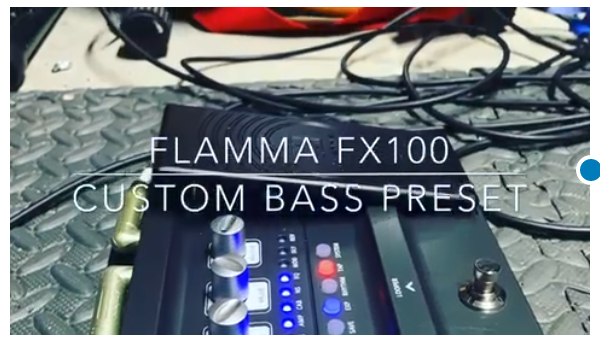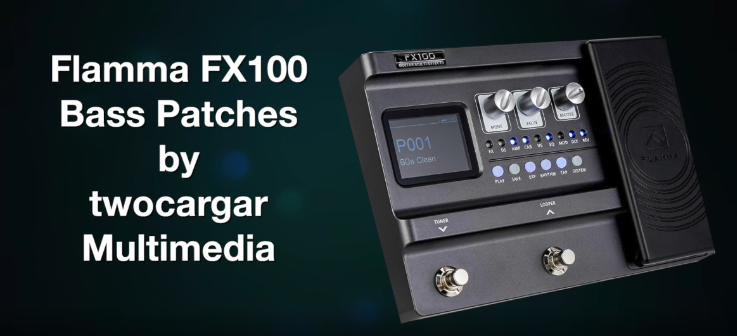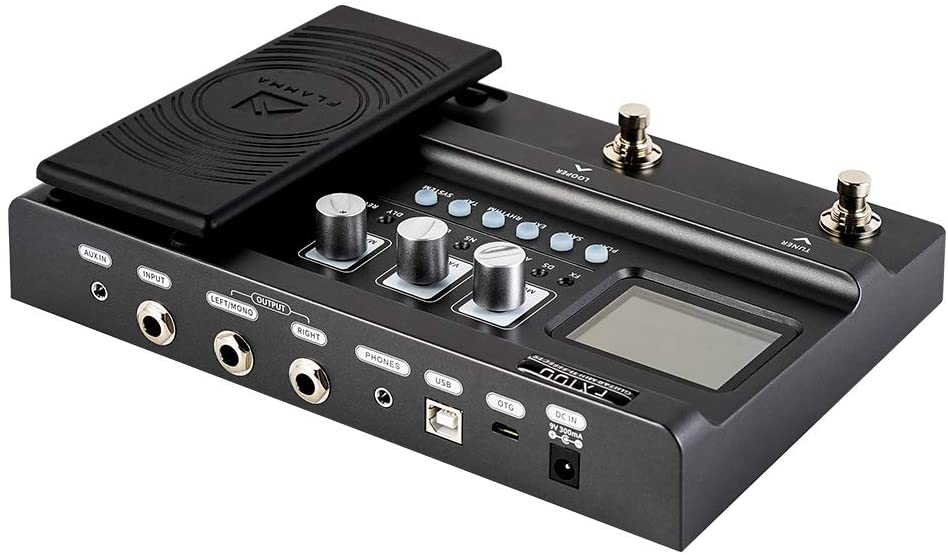
Affordable pedals have been an interest of mine for a while now. Finding something that is multi-function with the ability to edit the patches on a computer seems rare these days–at least I thought they were. When I do find a cool unit that ticks all of the boxes, they end up being aimed at guitarists and not bass players. I realize there is a bigger market for guitarists vs. bassists, so why not use guitar pedals in a bass rig? Part of the problem I’ve found is many guitar pedals are tone-suckers for bass guitar’s lower frequencies. My trusty Aria FL-5 Flanger (that I bought new in 1986) sucks the low end right out of my signal. Other than that the flanger effect sounds great. Maybe I can find some more pedals like the Joyo ones I’ve reviewed lately that sound decent and are a good value.
When I first came across the Flamma FX100, I was intrigued. Like I mentioned earlier it is clearly aimed at guitarists so there is not much at all mention of using this with a bass guitar. In the presets for amps and cabinets, there’s a Fender Bassman listed and that’s it other than the Fake Bass patch that uses the pitch shifter effect. Even Harley Benton DNAfx GiT which came out just a little while before has no mention of bass-aimed effects. I couldn’t find any downloadable patches for the FX100, DNAfx or even the Mooer GE150, which the Flamma and Harley Benton are close cousins.
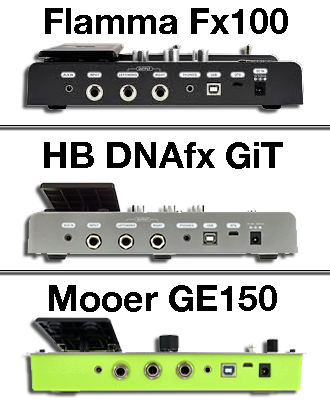
Flamma’s FX100 and Harley Benton’s DNAfx Git appear to be the same unit under the hood, with slight cosmetic differences. Even the Flamma’s FX100 manual shows a HarleyBenton volume pedal from the DNAfx Git and the HB logo in the screenshot of the software editor. The Mooer GE150 is also related, the first of these to be released but has a bit different layout of the top of the pedal. See the image above with a comparison of all three pedals showing their backsides, as it were. All of the units share the same rear panel, with (right to left in above photo) 9V power input, OTG mini USB, USB A for connecting to PC or Mac, 1/8″audio in, right audio out, left mono audio out, guitar in, headphone out.
Because there are three similar units (most likely made by a single manufacturer) that share the same software, there must be some information on how to download these presets and install them. Unfortunately the Flamma manual is not much help, neither are the HarleyBenton or Mooer’s. They all mention that it’s a thing, but don’t go into detail. I guess it’s up to me to figure it out and see if I can be of assistance. We’ll throw it up on YouTube and see if it’s helpful. I’m very surprised because the reviews that I’ve seen really don’t go into detail either. This is one of the things that drew me to it! The ability to edit and save your patches is HUGE!
Here’s a patch list I’m working on, with bass patches that sound like Geddy Lee, Chris Squire, Lemmy, Duff McKagen and Cliff Burton. I am going to package these up in a ZIP file for download. It’s fairly simple to download and install other patches.
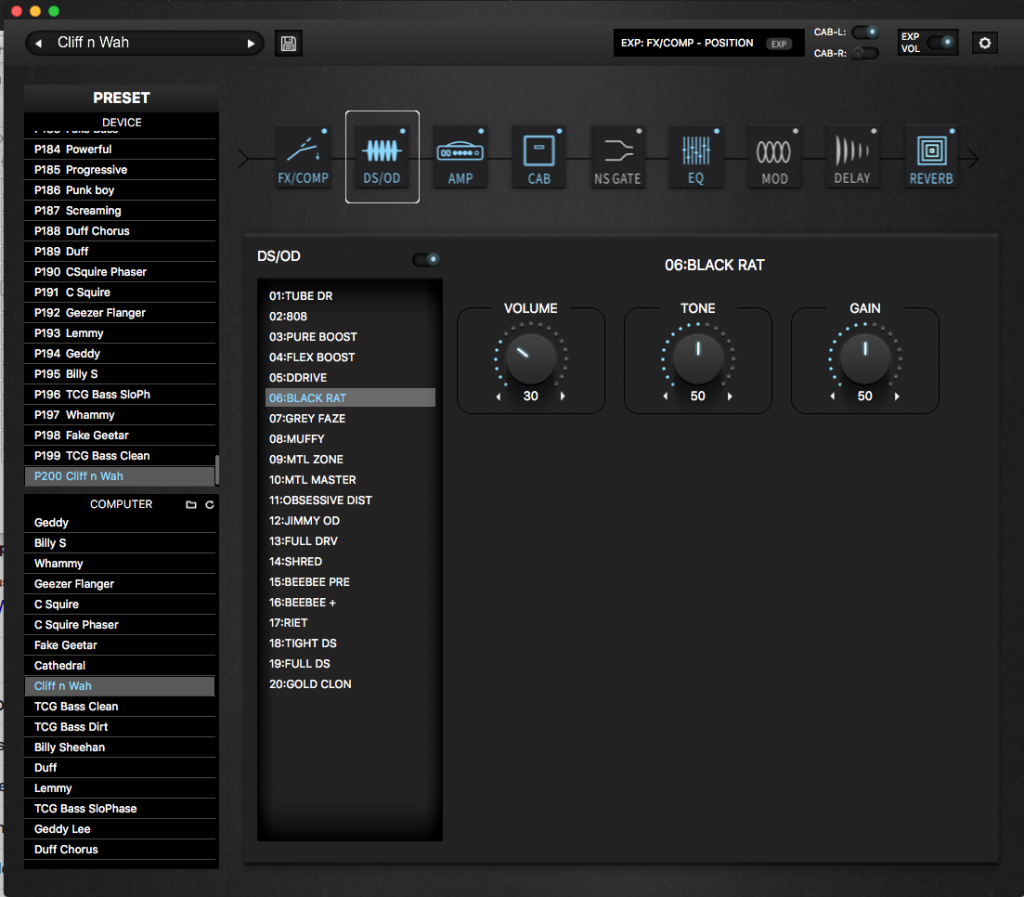
There are also places on the web where you can download amp cabinets, bass cabinets in this case. Here’s a couple I used: (download at your own risk)
- https://www.drbonkerssoundlab.com/product/dr-bonkers-in-this-together-cab-pack-ir-collection/
- https://laptopguitarist.com/2016/12/20/free-le-chatelet-bass-cabinet-impulse-responses/
There are also a couple videos that talk about loading cabinet profiles (impulse response files) using the Harley Benton DNAfx GiT. One in particular is really good, it’s in German and I don’t “sprechen”, but I was able to follow along because he’s got good visuals.
More to come on this! -Terry
My Amazon.com review:
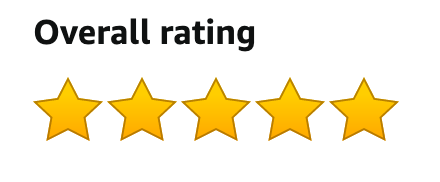
Affordable pedals have been an interest of mine for a while now. Finding something that is multi-function with the ability to edit the patches on a computer seems rare these days–at least I thought they were. When I do find a cool unit that ticks all of the boxes, they end up being aimed at guitarists and not bass players. I realize there is a bigger market for guitarists vs. bassists, so why not use guitar pedals in a bass rig? Part of the problem I’ve found is many guitar pedals are tone-suckers for bass guitar’s lower frequencies. My trusty Aria FL-5 Flanger (that I bought new in 1986) sucks the low end right out of my signal.
When I first came across the Flamma FX100, I was intrigued. Like I mentioned earlier it is clearly aimed at guitarists so there is not much at all mention of using this with a bass guitar. In the presets for amps and cabinets, there’s a Fender Bassman listed and that’s it other than the Fake Bass patch that uses the pitch shifter effect. Put all that behind you and dive in. I’ve created my own bass patches and they sound great. It was easy to configure using a USB cable and plugging it into my computer. Once I downloaded the Flamma editor from their website, it was easy to navigate the pedals controls from my computer. I found out you can even download and install guitar and few bass cabinet IR (impulse response files).
The pedal itself is well made and is very easy to use even if you don’t have it plugged into your computer. It only took me a few minutes to figure out how the three knobs on the front of the unit worked. What I like about it is the versatility. With editable patches, I can easily switch from guitar to bass and back. Some of the patches can even be used for both guitar and bass. This is a great unit and an excellent value! There’s so much more I can do with it, as I haven’t even touched the looper or drum machine function. Check out the videos on YouTube. There are plenty of good ones!
Clicking on the Amazon ads in this website helps me. I’m an Amazon affilate.